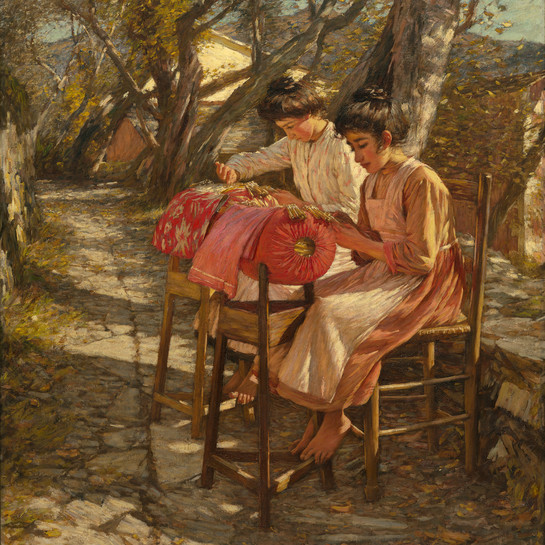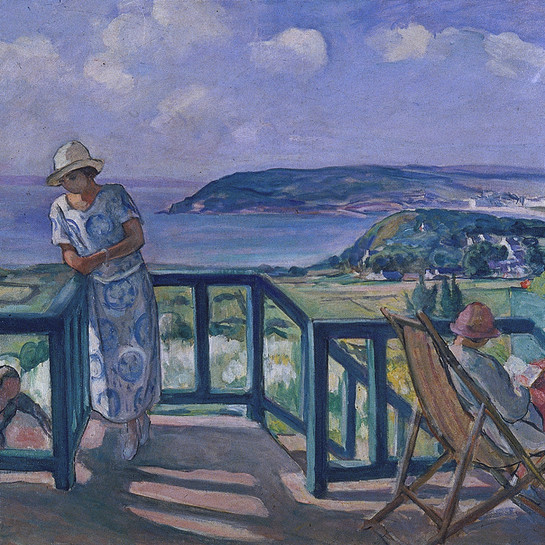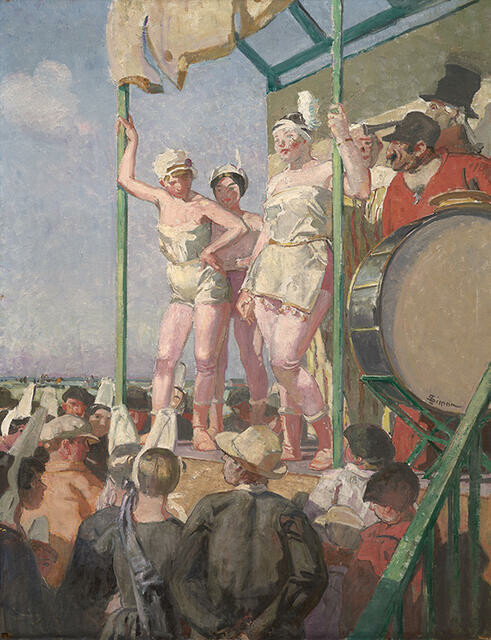Lucien Simon
France, b.1861, d.1945
Fête Foraine
Funfair
- c. 1926
- Oil on canvas
- Purchased through May Schlesinger bequest, 1938
- 1848 x 1400mm
- 69/531
Tags: actors (performing artists), circuses (performances), drums (membranophones), hats, musical instruments, people (agents), performing artists, side shows, spectators (event observers)
The unconventional, itinerant life of circus performers – and the sense of escape from routine they represented – is grandly captured in this colourful fairground scene, painted in 1920s coastal Brittany. Lucien Simon discovered the setting, with its distinctive light and picturesque inhabitants, after his marriage in 1891 to Parisian portrait painter Jeanne Dauchez, whose parents bought a summer retreat at the village of Bénodet. Lucien and Jeanne visited often and in 1901 bought an abandoned sémaphore (navy signal house) in nearby Sainte-Marine, which was a much-used second home and painting studio for many years. Simon became famous for his sympathetic representations of the Breton people, painting village dances, church processions, labourers and harvest scenes.
(Leaving for Work, 2 October 2021 - 1 May 2022)
Exhibition History
Weight of Sunlight, 15 September 2017 – 16 September
A small, sketch version of this painting titled 'Parade foraine à Kérity' locates this fairground scene in coastal Brittany, France – a region that became a magnet for many artists. For Paris-born and -based Lucien Simon, its distinctive light and picturesque inhabitants and traditions remained captivating for over half a century. Simon discovered Brittany after his 1890 marriage to Parisian portrait painter Jeanne Dauchez (1869–1949), whose parents purchased a summer retreat at the seaside village of Bénodet in 1891. Lucien and Jeanne made frequent visits, and in 1901 bought an abandoned sémaphore (navy signal house) at nearby Sainte-Marine, setting it up as a second home and painting studio, a well-used hub for many years. Simon became well-known for his affectionate portrayal of bourgeois family life (his own – the Simons had four surviving children) and of the customs of the Breton people. As well as fairgrounds, his subject-matter included village dances, courting youth, church processions, mourning, labouring and harvesting.
Lucien Simon first began producing paintings relating to the circus in Brittany during the late 1890s. He was associated with the plein air (outdoor) artists who painted around the small towns of Brittany and Northern France. Influenced by the paintings of Édouard Manet (1832 -1883), the thick impasto paint and the immediacy of the brushwork add to the sparkle and life of the sideshow scene. Simon has taken a realist approach where the performers are not glamorised nor the setting exaggerated. Simon was born in Paris. He painted portraits and rural scenes, and during the 1890s was a member of La Bande Noire (the Black Group) whose members also included Charles Cottet (1863 - 1925) and Andre Dauchez (1870 -1948). Simon exhibited regularly at the Paris Salon and, in 1893, also began exhibiting at the Société Nationale des Beaux-Arts. In 1900 he was awarded the Legion of Honour as well as a Gold Medal at the ‘Universal Exposition’, Paris. He became an Officer of the Legion of Honour in 1911. (Label date unknown)



